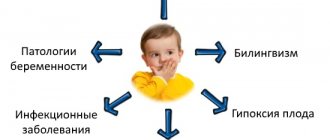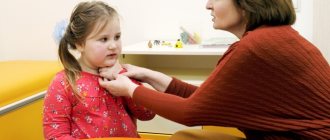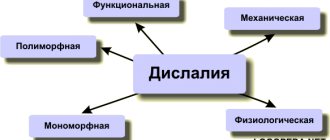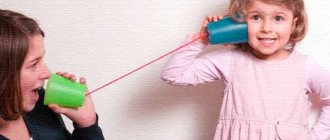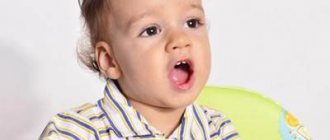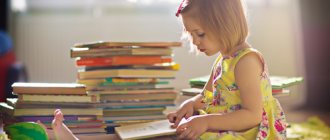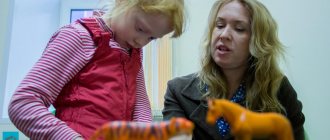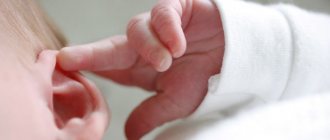Article:
There is no certain period of time during which one can and should intensively engage in the development of speech - and that’s it - as if by a wave of a magic wand, the baby took and spoke in whole sentences.
This is a rather lengthy process and takes its own time for each individual child. Parents lay the foundations on which knowledge and skills are laid like bricks. Speech development is not only dealt with from one to two years of age, until the child speaks - this is a process that has no clear boundaries. Many adults are actively developing and improving their speech and speech skills.
Factors on which speech development depends
Each child is individual, but psychologists and speech therapists identify four main factors that influence speech development:
- Anatomical features - the correct structure and functioning of the speech apparatus (tongue, palate, larynx, vocal folds), correct breathing.
As soon as the baby is born, he is immediately examined by a neonatologist and pediatrician, and during the first year of life by other specialists - a neurologist, dentist, etc. This is done in order to exclude various birth defects, to identify any diseases or predispositions in the early stages, and also prevent the development of the disease.
If deviations from normal development are detected, the doctor will be able to recommend correcting the anatomical defect, or preparing for subsequent correction. For example, a shortened frenulum does not allow the tongue to fully move in the oral cavity, and it does not reach the palate. Thus, it predetermines the occurrence of incorrect sound pronunciation.
- Physiological component. The connection between the brain and fine motor skills has long been proven - by developing small hands, you can activate speech centers.
There are a huge number of finger games and activities aimed at developing tactile sensations (various cereals, objects of different shapes and sizes, etc.). The most well-known and beloved game is “Magic Bag”.
- Emotional component. This is, first of all, a close emotional connection with mom and dad.
It is considered ideal for a child to communicate with grandparents (on both sides), brothers and sisters. The more the baby communicates with his family, the faster he joins in the conversation with them (he will wink at some, “hug” at others, and say something to others).
- Social component. First, the baby begins to communicate with his parents by screaming, when this is the only way he can say that he is experiencing discomfort, then, when recognizing familiar faces, he fixes his gaze, begins to smile, reaches out with his arms, etc. Therefore, everything that the child does is important - be sure to express emotionally your joy, tenderness, admiration.
In addition, in addition to the above factors, many specialists (speech therapists, psychologists, speech pathologists) indicate the influence of the speech of others - especially correct from the point of view of phonetics. For example, if one of the parents “burrs,” then most likely the son or daughter will do this based on imitation of a significant adult.
In this case, it is advisable to correct the pronunciation of the sound P in parallel between the child and the adult.
How a child’s speech is formed from birth to 3 years
The baby learns to communicate with the outside world from the very moment of birth. Let's take a look at how the speech development of young children occurs during the first 3 years of a child's life.
Norms of speech development in children from 0 to 3 years old
- 0 – 2 months. Scream. The first form of communication for a child is crying. The baby cries when he is hungry, uncomfortable or tired.
- 2 – 3 months. Booming. Crying is replaced by cheering. The sounds “a”, “s”, “u” appear, sometimes in combination with “g”. The child learns to understand speech addressed to him and control his own sound intonations.
- 3 – 6 months. Babble. The baby begins to babble to himself and make sounds when addressed to him. Turns his head towards the sound. Freezes in response to a sudden loud sound. Cries differently depending on needs: “I’m hungry,” “I’m tired.” Recognizes his name and reacts to it.
- 6 months. First syllables. From the age of 6 months, you can notice that the child prefers strictly certain sounds to all others: “ba”, “ma” (they are the easiest to learn to pronounce). He can repeat them endlessly: he likes the way they sound.
- 7 – 9 months. Combinations of syllables. The babbling progresses to the utterance of identical syllables: “ma-ma-ma”, “dya-dya-dya”, “ba-ba-ba”.
- 9 – 11 months . Onomatopoeia. The baby imitates the sounds of adults' speech. Responds to name. Understands the meaning of the word “no.”
- 11 – 13 months. The first meaningful words from two identical syllables: “dad”, “mom”, “baba”, “uncle”.
- 12 months. The baby shows interest and attention to the speech of others, repeats and combines sounds in a new way, combines them into “words”, imitating the speech of an adult. Understands and follows simple one-word instructions (“sit down”). He waves his hand “bye-bye”, shakes his head “no”. Uses gestures and sounds to attract attention. Interested in books.
Rarely does a parent know what signs indicate deviations in the child’s development. Therefore, for prevention, be sure to visit a pediatric neurologist at 3, 6, 9 and 12 months .
- 18 months. The baby easily repeats frequently heard words. Knows different parts of the body and points to them. Masters simple words (by the age of 2 years, their vocabulary can range from 20 to 50). Answers in words or gestures the questions: “Where is the bear?”, “What is this?” He loves when people read to him. At the request of an adult, he points his finger at the pictures in the book. 2 years. First sentences (two words). A two-year-old child can easily combine simple words mastered by the age of 2 into combinations: “Mom, give me,” “I want this,” “Where is the kitty?” Understands simple instructions consisting of two sequential actions: “Find your teddy bear and show it to grandma.” The vocabulary can expand to 150 - 200 lexemes, and others can already understand half of the words the child pronounces. The baby begins to use pronouns, adjectives and prepositions. Holds a book correctly in his hands. “Reads” to his toys.
- 3 years. Multi-word sentences (three or more words). At 3 years old, the period of early childhood ends. By this turning point, the child is able to compose sentences of three or more words. Distinguishes between colors and size definitions. Remembers and repeats familiar rhythms, melodies, stories. Some difficulties in sound pronunciation may still persist (whistling, hissing, vowel sounds). The vocabulary is expanding so much that parents can no longer accurately count how many words it consists of. In general, the baby is already ready to speak out on any occasion.
Introduction
Nowadays, the development of speech in children at an early age is one of the most important and main problems, since not all children develop speech according to established standards. This problem is considered most deeply by Gribova O.E. “What to do if your child does not speak / A book for those who are interested” [3] and Tkachenko T.A. “If a preschooler speaks poorly” [13].
Purpose of the work: to study the stages of development and methods of speech formation in young children.
Object of study: preschool children.
Subject of research: stages of speech development and methods of its formation.
Research methods:
- Research theoretical material on the topic of speech development in young children.
- Formation of a methodological piggy bank for speech development.
Types of speech
Speech can be active or passive:
- Active - the one that the baby uses. The child knows the words he has learned, can confidently pronounce them, and construct sentences with their help.
- Passive is the one that the child understands, but for certain reasons does not pronounce. For example, he may know the word “TV”, but not say it because it is difficult for him.
It is very important to develop both active and passive speech of a child.
How to help develop speech by age
Up to a year old, the baby makes his first attempts to speak - he smiles in response to visual and verbal contact with adults, tries to say some sound or even repeat after mom or dad. Therefore, it is very important to focus on these attempts, smile, look at the baby, showing in every possible way that you are interested.
1-3 years. At this age, mothers and fathers, when communicating with a child, try (on an unconscious level) to speak to the baby in his language - briefly, understandably, clearly. Thus, the child understands what is being said to him, what he wants to say. Try to get rid of baby talk and empty repetition (such as “ba-ba”, “peek-a-boo”). The child must hear the words in full so that later he can say them the same way, and not shorten the syllables, rearrange them, distorting the meaning. Correct speech stimulates communication.
From 3 years and older. The most common opinion of most modern parents is that by sending a three-year-old child to kindergarten, the pace of communication can be slowed down, and all the necessary speech skills will be developed by the employees of the child care institution. This is wrong. Parental communication remains just as important, because it is in the family that the foundations of communication are laid, on which the rest of the acquired knowledge will be superimposed.
Conclusion on Chapter I
From the very first days of life until the end of the preschool period, children have the most important task - the formation and development of speech. Each year of a child’s life is divided into stages and at each of them speech is improved - from the first infant cry to the composition of complex sentences.
During early childhood, children undergo intensive speech development. During this time, the child’s active vocabulary exceeds the passive one; the child learns that each object has its own name; after he hears the word, he tries to repeat it; he learns to compose simple and complex common sentences.
The development of a child’s speech is closely related to communication with adults, and a lack of this communication can lead to delayed speech development and also affect the development of the baby’s psyche. A child’s communication with the people around him allows him to increase his passive and active vocabulary, improve his pronunciation and the content of his speech.
How to help young children develop speech
What can we, parents, do from the very birth of a child to ensure that he speaks naturally?
Let us remind you that the sensory channel for perceiving information about the external environment (vision, hearing, taste, smell and touch) is the main one for children in the first years of life.
Therefore, the answer lies on the surface: it is necessary to give the child as much information as possible about the world around him, as much as possible of any kind of sensory sensations and stimuli. Let's talk about it.
- Touch. Feeling #1 at first.
Mother's warm hands, her gentle touches, stroking, massage, gymnastics, toys of different shapes and textures, finger games - the more of this, the better.
Knowledge about oneself, one’s body and its sensations is formed through contact with the environment, so diversify the child’s tactile sensations as much as possible. Water of different temperatures (carefully!), soft fabric and rubber balls, a plastic rattle and a wooden cube, finger paints on a palette, sand in a children's sandbox, beans in a jar, etc. - the world is so rich for training your sense of touch!
- Hearing.
Give your baby as much information as possible that he can perceive by ear:
- sounds of music
- nature
- household appliances in the house
- street noise from the window
- sounds of native speech, etc.
Always talk to your baby about everything. Mom does this naturally, because speech accompanies any of her actions: she voices swaddling, feeding, bathing, and putting her to bed. She names objects surrounding the child, pointing at them.
When the baby starts to walk, the mother “keeps up the conversation”: she responds to the sounds the baby makes, repeats them and introduces him to adult speech, which the baby will try to imitate as he grows up.
- Vision.
We interest the baby in the objects around him so that he learns to focus his vision and maintain his attention on significant objects.
To help your child concentrate, you can hang bright colored objects above the crib (for example, balloons, fluffy pom-poms - they are quite light and will certainly attract attention).
Some mobile models come with removable toys to help adults provide a stimulating and varied space for their child. This is for the little ones.
Later, the arsenal of objects from the surrounding reality can be replenished endlessly, both due to toys in the house, and due to the visual impressions that the baby will receive when he is outside the home: on a city street, on a river, in a forest, in a zoo.
- Taste.
Mother's milk, water, teas, juices, pureed and solid food - what a variety of textures and tastes! Introduce your baby to them by gradually expanding the range of products that you introduce into baby food. The sooner a child becomes familiar with basic tastes, the less picky he will be in food later.
Article:
Early childhood is a sensitive period for language acquisition.
The child’s autonomous speech transforms and disappears quite quickly (usually within six months). Words that are unusual both in sound and meaning are replaced with words of “adult” speech. Conditions of speech development. The transition to a new level of speech development is possible only in favorable conditions - with full communication between the child and adults. Stages of speech development. At the age of 1 to 3 years, there are 3 stages of speech development in children. The first stage of speech development occurs between the ages of one and 1.5 years and is associated with the formation of passive and active speech. Passive speech. At an early age, the passive vocabulary—the number of words understood—grows rapidly. The adult’s speech, which organizes the child’s actions, is understood by him quite early. By this time, the child begins to understand the adult’s instructions regarding joint actions. However, until about 1.5 years of age, the child only develops understanding of speech, with a very slight increase in the active vocabulary. First of all, the child learns the verbal designations of the things around him, then the names of adults, the names of toys and, finally, parts of the body and face. These are all nouns and are usually acquired during the second year of life. By the age of two, a normally developing child understands the meaning of almost all words related to the objects around him. Active speech. Active speech is also developing intensively: the active vocabulary is growing, while the number of words spoken is much smaller than those understood. A child begins to name things in his own words at the age of about one year. By this time, children usually already have ideas about the world around them in the form of images. Under these conditions, to begin mastering speech, the child only has to associate the images he has with combinations of sounds pronounced by adults in his presence when there are corresponding objects or phenomena in his field of vision. Speech grammar. The first period of speech development, covering the age of 1 to 1.5 years, is characterized by weak development of grammatical structures and the child’s use of words mostly unchanged. The second stage of speech development occurs at approximately 1.5 to 2.5 years of age. In the second year of life, the child’s active vocabulary increases sharply. By the age of one and a half years, a child on average learns from 30-40 to 100 words and uses them extremely rarely. After one and a half years, a sharp leap in speech development occurs. By the end of the second year of life, children already know approximately 300 words, and by the age of three, 1200-1500 words. At this same stage of speech development, children begin to use sentences in their speech. The child's interest in the world around him grows. The child wants to know, touch, see, hear everything. He is especially interested in the names of objects and phenomena, and every now and then he asks adults the question: “What is this?” Having received the answer, the child independently repeats it, and, as a rule, learns the name immediately, without much difficulty remembering and reproducing it. A child’s passive vocabulary at this age is not much different from the active one, and their ratio at the age of three is approximately 1:1.3.
Offers. At first, the child uses one-word sentences that express a complete thought. Such words-sentences arise in connection with some specific, visually perceived situation. Then two-word sentences appear, including both a subject and a predicate. The meaning of such two-word sentences is the same: a certain thought or a complete statement. This is most often the subject and his action (“Mom is coming”), the action and the object of the action (“give me a roll”, “I want candy”), or the action and the place of action (“the book is there”). At this age, children learn to combine words, combining them into small two- or three-word phrases, and they progress from such phrases to complete sentences quite quickly. The second half of the child’s second year of life is characterized by the transition to active independent speech, aimed at controlling the behavior of people around him and mastering his own behavior. Speech grammar. The second period of speech development represents the beginning of the intensive formation of the grammatical structure of a sentence. At this time, individual words become parts of a sentence, and their endings are agreed upon. By the age of three, the child generally correctly uses cases, constructs multi-word sentences, within which the grammatical coordination of all words is ensured. Around this time, conscious control over the correctness of one’s own speech utterance arises. The third stage of speech development corresponds to the age of 3 years. By the age of three, the basic grammatical forms and basic syntactic structures of the native language are mastered. In a child’s speech there are almost all parts of speech, different types of sentences, for example: “Do you remember how we went to the river, dad and Nyura swam, and where was mom?” “I am my father’s and mother’s son, the nephew of all my uncles, my grandmother’s and grandfather’s grandson.” “You are big, and I am small. When I’m long - up to the carpet... up to the lamp... then I’ll be big.” The most important acquisition of a child’s speech at the third stage of speech development is that the word acquires an objective meaning for him. The child uses one word to denote objects that are different in their external properties, but similar in some essential feature or way of acting with them. The first generalizations are associated with the emergence of objective meanings of words. Functions of children's speech . The communicative function of children's speech is associated with the use of speech as a means of communication, controlling the behavior of other people and self-regulation. At the age of one to three years, the child’s social circle expands - he can already communicate through speech not only with close people, but also with other adults and children. What does a child say when communicating with adults? Basically, the child’s practical actions or the visual situation in which communication takes place. The child answers the adult’s questions and asks questions about what they are doing together. When a child enters into a conversation with a peer, he delves little into the content of the other child’s remarks, therefore such dialogues are poor, and children do not always answer each other. The semantic function of children's speech is associated with determining the meaning of words and the acquisition of generalized meanings by words.
Between one and three years of a child’s life, there is a stage of speech development when polysemantic words appear in the child’s speech. Their number is relatively small, from 3 to 7% of a child’s vocabulary. Next, polysemantic words disintegrate, and words in the child’s speech acquire stable meanings. At the age of one to 1.5 years, stages of development of verbal generalizations can be distinguished in a child’s speech. At the first stage, the child groups objects according to their external, most striking and conspicuous features. At the second stage, generalization occurs according to functional characteristics, that is, according to the role in which objects are used in children's play. The third stage is characterized by the ability to identify general and stable characteristics of objects, reflecting their nature and independent of the situational, functional use of these objects. Cognitive function of speech. Around three years of age, the child begins to listen carefully to what adults say to each other. He especially likes listening to stories, fairy tales, and poems. At 2-3 years old, understanding of speech-story appears. Stories relating to things and phenomena surrounding the child are easier to understand. In order for him to understand a story or fairy tale, the content of which goes beyond the limits of the situation directly perceived by him, additional work is needed - adults must specially teach this. The emergence of the cognitive function of speech determines an important moment in the child’s speech development. It indicates that the child is already able to perceive reality not only directly through the senses, but also in its ideal, conceptual reflection in language. Psychological mechanisms of speech development. How is a child’s speech formed from the point of view of the psychological mechanisms of this process? There are three main mechanisms of language acquisition: - imitation, - formation of conditioned reflex associations, - formulation and experimental testing of empirical hypotheses. Imitation influences the formation of all aspects of speech, but especially phonetics and grammar. This mechanism is realized when the child shows the first signs of the corresponding ability. But imitation is only the initial stage of speech development. Without the next two stages, it is not able to lead to great success in language acquisition. The function of conditioned reflex conditioning in the production of speech is that the use of various rewards by adults accelerates the development of children's speech. It cannot be said, however, that without this the child will not develop speech at all. It is known that in orphanages children are deprived of individual attention. And yet, under these conditions, the child’s speech is still formed by the required time. The formulation and testing of hypotheses as a mechanism of speech acquisition is confirmed by the facts of active children's word creation. However, isolated on its own, this mechanism overly intellectualizes the process of speech development in young children. Apparently, speech development at an early age is explained by a combination of all three learning mechanisms considered.
Today, the issue of speech development in preschoolers is especially acute. This is probably due to the fact that children, and adults too, began to communicate more with computers and other means of technological progress than with each other.
Preschool age is the most favorable for the development of speech and the formation of a culture of verbal communication. Practice shows: this is a very labor-intensive and responsible work that requires a certain system and patience on the part of the teacher in selecting the most effective means and methods of teaching.
But in order to teach children something, the teacher needs to work on himself. A preschooler spends most of his time in kindergarten: he communicates with the teacher, learns a lot from him, including speech culture. Therefore, I pay special attention to my speech. The child perceives the adult’s speech as a model; the teacher must speak correctly, without distorting sounds, clearly articulating each word, without rushing, without “eating” endings. You need to pronounce unfamiliar and long words especially clearly. Liveliness and richness of intonation also play an important role - they contribute to better assimilation of speech. You also need to regulate the pace of your speech. It is difficult even for an adult to follow the content of speech that is too fast, but a child is completely incapable of this. Not understanding the meaning of the flowing streams of words, he simply stops listening. Speech that is too slow and drawn out is also unacceptable: it becomes boring. You should also regulate the strength of your voice, speak as loudly or quietly as the conditions of the moment and the content of the speech require. Children do not hear quiet speech and do not grasp its content. Children adopt loud speech, turning into a scream, as a manner of speaking, unusually quickly. I try to make my speech emotional, expressive and reflect interest, attention, love for the child, and care for him.
In the process of verbal communication with children, I also use non-verbal means (facial expressions, pantomimic movements), which perform important functions:
- help to emotionally explain and remember the meaning of words. A well-aimed gesture helps to learn the meanings of words (round, big...) associated with specific visual representations;
- help clarify the meanings of words associated with emotional perception (cheerful, sad, angry, affectionate,...);
- contribute to deepening emotional experiences, memorizing material (audible and visible);
- help bring the classroom environment closer to that of natural communication;
- are models of children's behavior;
• perform a social, educational function.
Regular moments are favorable for organizing proper verbal communication: dressing children for a walk, undressing after a walk and before bed, washing before each meal, observing natural phenomena, being on duty, excursions. All these moments are directly related to some real objects, about which you can organize a conversation with children. At the same time, a certain range of knowledge and ideas is formed, and children’s speech is activated.
I strive to develop children's speech activity, tactfully correct mistakes (wrong emphasis in a word or grammatical error), suggest words when the child does not know how to express his thought, correct the child if his tone is incorrect, if he speaks too loudly.
Every teacher must remember: only the correct form of presenting comments and recommendations for correcting speech errors has a positive effect on the development of the child’s speech. When correcting a mistake, you should not repeat it - you need to invite the child to listen to how to speak correctly, warning him that he said incorrectly, which means he must repeat the correct word or sentence after the teacher.
Everyday communication gives me the opportunity to enrich the children's vocabulary. For example, during daily dressing and undressing with children, I talk about what they put on or take off, what color the clothes are, what material they are made of, as well as other external features: soft, fluffy, striped, long, warm, new and etc.
For example: children dress for a walk. I talk about everything they wear: “First, the children put on their pants. They are different. Sasha has green ones, Nikita has blue ones, Masha has brown ones... Zhenya has boots with laces, and Anya has ones with a strap, Katya has boots,..."
Developing attention to speech in the process of self-care, I give instructions for work and make sure that they are carried out correctly.
When children wash themselves, we can talk about what they wash (face, hands, ears, body), what they wash with (water, soap, brush), what kind of water (hot, cold, warm), what kind of soap (scented, aromatic, white, etc.) with what to dry (white, clean, striped towel, etc.).
While setting tables as an assistant teacher, I draw the children’s attention to the dishes, talk about the dishes, and how to place them on the tables. In the stories I use names, demonstrate the shape, color, design, the material from which it is made, its properties (it breaks), the number and place of different pieces of utensils on the table.
The younger the children, the more often the teacher should accompany his actions with words. The teacher must name objects and actions himself, but also ask the children questions: What are you doing? What are you playing? What are you building? What are you wearing? What do you wash your hands with? etc.
It is also necessary to consolidate the skills of general and speech behavior. This technique is very useful: I instruct one of the children to explain to the child where in the group he can get toys, books and talk about the rules for handling them.
It is important to properly organize the observation of the work of adults during walks and excursions in order to make maximum use of the observed objects for the development of various aspects of speech.
Games also contribute to speech development. Thus, I always accompany role-playing games with speech: children agree on the terms of the game, argue, and conduct dialogues on behalf of the characters. But not all children willingly participate in games: some have more speech activity, others have less. Therefore, I try to introduce active games into children’s lives, which are accompanied by dialogues.
For the full speech development of a child, the family plays a role. I explain to parents that a speech game or exercise, a conversation with a child, is an integral part of the complex process of speech formation. If parents withdraw from this work, their child will suffer. I introduce parents to games, play exercises and tasks, selecting and taking into account the heavy workload of parents with daily household chores, and the fatigue accumulated by the end of the day. Among others, I recommend “playing in the kitchen” at home.
For example.
Game exercises to develop fine motor skills:
- “I’m helping mom” (sort through rice, peas, buckwheat),
- “Magic wands” (use pencils to assemble simple geometric shapes).
Games to enrich a child’s vocabulary:
- “Let's look for words in the kitchen” (what words can be taken out of the kitchen cabinet, borscht, etc.),
- “I’m treating you” (let’s remember delicious words and treat each other. The child remembers the “delicious” word and “puts it” on your palm, then you put it on his palm, and so on until you’ve “eaten everything.” You can play “sweet” , “sour”, “salty”, “bitter” words).
You can play to develop the grammatical structure of speech.
“Let's make juice” Juice from apples... (apple); from pears... (pear); from cherry... (cherry); from carrots, lemon, orange, etc. Did you manage? And now it’s the other way around: what is orange juice made from? etc.
It is good to offer game exercises for the development of fine motor skills:
- While you are busy sewing on buttons, your child can make beautiful patterns out of buttons and bright threads.
- Try making a panel of buttons with your child. Buttons can be sewn on (with your help), or you can strengthen them on a thin layer of plasticine (without your help).
On the way from kindergarten (to kindergarten)
- "I noticed". “Let's check which of us is the most attentive. We will name the objects we pass by; and we’ll also be sure to indicate what they are. Here's the mailbox - it's blue. I noticed a cat - it’s fluffy.” The child and the adult can name the objects they see in turn.
- "Magic glasses". “Imagine that we have magic glasses. When you put them on, everything turns red (green, blue, etc.). Look around with magic glasses, what color everything has become, say: red boots, red ball, red house, red fence, etc.”
"In a free moment." A game exercise on the syllabic structure of words.
- "Confusion." “Once upon a time there were words. One day they were having fun, playing, dancing and did not notice that they were mixed up. Help the words unravel. Words: bosaka (dog), lovosy (hair), lekoso (wheel), posagi (boots), etc.”
A game to enrich a child's vocabulary
“Say the word.” You start a phrase, and the child finishes it. For example: a crow croaks, a sparrow... (chirps). The owl flies, and the hare.. (runs, jumps). The cow has a calf, and the horse... (foal), etc.
"Stubborn words." Tell your child that there are “stubborn” words in the world that never change (coffee, dress, cocoa, piano, subway...). “I'm putting on my coat. A coat hangs on a hanger. Masha has a beautiful coat, etc. Ask your child questions and make sure that he does not change the words in the sentences - answers.
Outdoor games
"Ball Games" “I will name objects and throw you a ball. You will catch it when you hear the sound “w” in a word. If the word does not have such a sound, then there is no need to catch the ball. So, let's begin: toad, chair, hedgehog, book..."
“Frog” Isolating a sound from a series of vowels: a, o, u, i, e, e, yu, i, s “You will jump like a frog, if you hear the sound “a”, you lower your hands to other sounds.” You can also play a game on consonants.
This is the joint work of the teacher and the family on speech development that provides the full speech development of the child.
Working on the development of children’s speech and planning our work, I believe that we, adults, should not forget the main thing, the development of children’s language, love for their native language is the most important acquisition of a child in preschool childhood.
And finally, I would like to say: the culture of speech presupposes the general culture of a person, a culture of thinking and a love of language.
Songs, rhymes and nursery rhymes for speech development in children 2 - 3 years old
These are perhaps the most effective, generation-tested ways of communicating with young children.
Basic principles:
- simple rhyme
- repetition of sounds or words
- small size
- accompaniment with gestures/actions
Rhyming poems can be told, or they can be sung using various melodies.
The main purpose of nursery rhymes, finger games, rhymes:
- emotional contact with the child
- development of his speech skills
- finger massage
- study of body parts
- assistance in establishing a routine
For example, by repeating the same rhyme before bedtime, you can develop in your child the expectation of a funny rhyme and the understanding that it is time for him to sleep.
IMPORTANT: Young children need consistency and order as this develops a sense of stability and security.
You can come up with or choose from the many available nursery rhymes, one for different occasions:
- morning hygiene procedures
rhyme for washing
- changing baby's clothes
rhyme when changing clothes
- preparation for swimming
bath rhyme
- before gymnastics
rhyme for gymnastics
- finger massage
poem for finger massage
- before bedtime
bedtime poems
The classic nursery rhymes “okay”, “cockerel-comb”, “horned goat”, “white-sided magpie” and many others will also delight the baby and be useful.
Playing and learning to speak: role-playing games for children
Options for playing with a child are limited only by the parents' imagination. At the same time, the child often independently suggests what he wants to do, distributes roles and organizes the game. Your mission is to fill the game with detailed dialogues so that the game is not only exciting, but also useful for the development of the baby’s speech. It can be:
- Hide and seek The classic game of “peek-a-boo” with infants can gradually change. You can hide behind anything, attracting the child with the words “where is mom?”, “find mom.” As the child grows up, he will begin to enjoy hiding on his own, and you, with appropriate verbal accompaniment, will look for him.
- Role-playing games At first, these can be very simple games. For example, you can play with a toy phone, a child can call mom, dad, brother, sister, say “Hello,” find out “how are you?” and vice versa. Then you can role-play fairy tales, come up with stories yourself, using household items and toys
- “Guess” There are many variations of games. You can ask your child: “guess what I’m doing?” and show some action: combing your hair, pouring tea into cups. Or ask: “guess who I am?” and depict a bunny or a bear cub. You can show soft animals and ask: “guess who it is?”, “what does he like to eat”, “where does he live?” If the child cannot answer, you should give a detailed answer yourself, and after a while repeat the questions to the child
- Active games Nursery rhymes and songs can be used in active play with the child, encouraging him to repeat the corresponding actions along with the words. This, in parallel with speech skills, will develop both the child’s physical and musical abilities. Examples:
nursery rhyme with movements 1
nursery rhyme with movements 2
Conclusion on chapter 2
The most effective method of developing the speech of a young child is his participation in various types of activities.
Productive activities (appliqué, modeling, drawing) form a child’s idea of the shape, color or properties of a particular object. During the lessons, the child develops imagination, fine motor skills and, most importantly, speech activity. The child discovers a lot of new things and wants to know about everything, this is how the child’s dialogue with an adult or teacher is formed.
Playful activities allow the child to improve not only the coordination of movements while playing with objects, but also the quality and quantity of words in his active vocabulary, as the child gives a name to the object/toy, comes up with a situation in which he is and explains his actions. Thus, we can say that play is a fruitful way to develop speech in children.
All the methods we propose contribute to the development and improvement of the child’s speech, and also help prevent its delay.
What mistakes can parents make when developing their child’s speech?
Often the child is overly patronized and protected, they try to predict his desires - of course, out of love for him. But then the baby does not develop the desire to work independently, he does not learn to express his thoughts through speech, and many processes in his development may be inhibited.
• Intuition and love help loved ones understand a child literally at a glance. But communicating with unfamiliar people in unusual conditions will be difficult for him, and in the worst case, acutely uncomfortable. To prevent this from happening, as you grow older, you need to enter into conversations more often with new and new interlocutors, and then the child will simply be forced to improve his speech understanding skills.
• Some parents underestimate, while others overestimate, the requirements for the baby’s speech. In the first case, they do not demand anything from the child, all his wishes are guessed and immediately fulfilled, in the second, they constantly pester him: “Tell me!”, “Repeat!”. Sometimes in one family two extreme approaches are used at once: for example, dad demands, and grandmother takes care. This has a very adverse effect on the child’s speech development.
• Try to eliminate lisping, “baby talk,” and constant onomatopoeia when communicating with your baby. The parent's speech is a model for the child.
• Parents can speak very quickly or, conversely, too slowly, without pauses and different intonations, monotonously. It is important to use all the richness and diversity of language when developing a child’s speech.
• Do not try to speed up the baby's natural speech development. Avoid overwork from speech classes and memorization of poetry.
How to determine that a child has speech delay
Delayed speech development is a later acquisition of oral speech in comparison with conventional norms for children under 3 years of age. Delayed speech development can be characterized by qualitative and quantitative underdevelopment.
In order to correctly understand how to determine delayed speech development, it is necessary to know the stages and conditional norms of speech development in children at an early age.
Normally, at 1 year of age, a child’s active vocabulary contains approximately 10 words, and the passive vocabulary contains about 200 words. Up to a certain time, the passive vocabulary is much larger than the active vocabulary. Approximately 1.6 - 1.8 months. words from the passive vocabulary burst into the active vocabulary. In some children, the period of passive speech lasts up to 2 years, although in general speech development is normal.
Deviations in speech development within the normal range are allowed for 2-3 months in girls, and 4-5 months in boys. Only a speech therapist can correctly understand whether a child has a speech development delay or not.
Signs of delayed speech development at different stages of speech ontogenesis may be: lack of response to sound and speech, inactive attempts to repeat other people’s words, absence of one’s own speech at different stages of its development, absence of non-speech methods of communication.
Causes of delayed speech development
Why did the child have a delay in speech development? Causes may include disturbances during intrauterine development and the birth process, as well as adverse effects that the child encountered in the first years of his life.
The most severe disorders occur during 3-4 months of intrauterine development. At this time, the fetal nerve cells form brain structures. The causes of delayed speech development in children associated with the course of pregnancy and childbirth can be factors such as early and late toxicosis of pregnancy, extreme prematurity, birth trauma, intoxication with chemicals and drugs. Delayed speech development may be influenced by genetic factors.
Pathologies during pregnancy and childbirth are not always the causes of underdevelopment. Sometimes disorders are caused by factors affecting the health and upbringing of the child - these are reasons of a biological and social order.
Biological factor . Biological factors include complications after vaccination, a slow rate of maturation of the nervous system, as well as long-term diseases that weaken the child’s immunity at an early age. The biological basis of RRD is most often the presence of minimal brain dysfunction in the child caused by perinatal brain damage.
Hearing loss. It is very dangerous if a child has reduced hearing or cannot hear anything. When hearing loss occurs, a child’s speech cannot fully develop. In this case, even minimal deviations from the norm can be considered the cause of RRD. It is very important at what age the baby lost his hearing. If this happened at 5-6 years old, the child can retain speech skills. When a child is born deaf or has hearing loss in the first years of life, the chances of such a child speaking are zero.
Social factors. Such factors include frequent stress, lack of attention and communication in the family.
Prevention
If parents notice that their child’s speech development is lagging behind the norm, then they definitely need to contact the right specialist. Neurologists, speech therapists, defectologists, and corrective teachers are working on solving this problem. In special cases, the help of a facial surgeon or orthodontist may be needed.
In case of impaired understanding of speech, incomplete mobility of the lips, tongue, low level of fine motor skills, if hearing impairment is suspected, the following studies are carried out: hearing test, examination of speech understanding, examination of fine and gross motor skills, examination of articulation organs, examination of vocabulary, examination of phrasal speech.
Based on the results of the examination, the degree of mental retardation is determined and corrective work is planned. How is delayed speech development treated? Drug therapy, magnetic therapy, electroreflexotherapy, dolphin therapy and hippotherapy are carried out; A teacher and proofreader works with the child.
With uncomplicated forms of pathology and with fully completed correctional work, by the time the child starts school, the delay in the development of the child’s speech will be overcome. To do this, it is important that parents support all the requirements and recommendations of specialists.
Measures to prevent speech delay:
- creating conditions for a favorable course of pregnancy and childbirth, the first years of a child’s life;
- the formation of a speech environment rich in educational toys and various objects;
- ensuring normal social conditions for the life and development of the child;
- assessment of speech development by a speech therapist no later than 2-2.5 years.
In order to quickly compensate for delayed speech development, you need to promptly pay attention to the child’s communication problems. There are several degrees and varieties of RRD, which only a specialist can diagnose. He will also find out the possible cause of the development of a speech defect affecting the central nervous system and brain.
